Picture a dining room where lush greenery frames intimate conversations and memorable meals. You’ll discover that strategically placed plants can transform your dining space from ordinary to extraordinary, creating an atmosphere that naturally draws guests in. Whether you’re hosting formal dinner parties or casual gatherings, these ten expert-tested plant decorating tips will help you design a space that makes lasting impressions – and they’re simpler to implement than you might expect.
Contents
- 1 Choose Statement Plants for Empty Corners
- 2 Create a Living Centerpiece That Lasts
- 3 Layer Different Plant Heights for Visual Interest
- 4 Select Low-Maintenance Plants for Busy Areas
- 5 Match Plants With Your Dining Room’s Style
- 6 Design a Hanging Garden Above the Table
- 7 Balance Natural Light With Plant Placement
- 8 Mix Textures and Leaf Patterns
- 9 Use Decorative Planters as Design Elements
- 10 Incorporate Seasonal Plants for Fresh Updates
Choose Statement Plants for Empty Corners
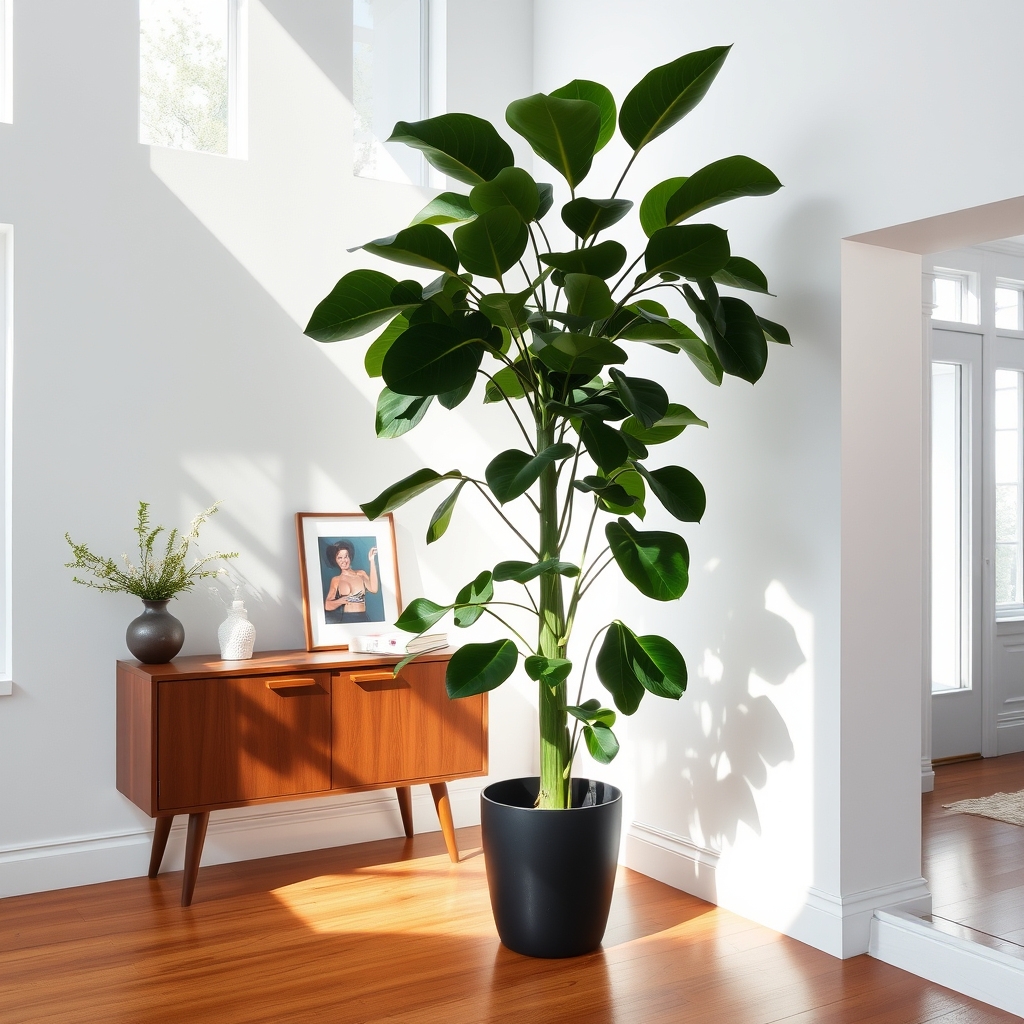
Statement plants for empty dining room corners serve as eye-catching focal points that add height, drama, and natural elegance to underutilized spaces.
These plants typically stand 4-6 feet tall with substantial foliage, creating visual impact while softening angular room transitions. Popular options include fiddle leaf figs, bird of paradise, monstera deliciosa, and tall palm varieties.
The plants are often displayed in oversized decorative pots or elevated planters that complement the room’s style. Their commanding presence naturally draws the eye upward, making the dining space appear larger while filling what would otherwise be dead corner space with vibrant greenery.
Create a Living Centerpiece That Lasts
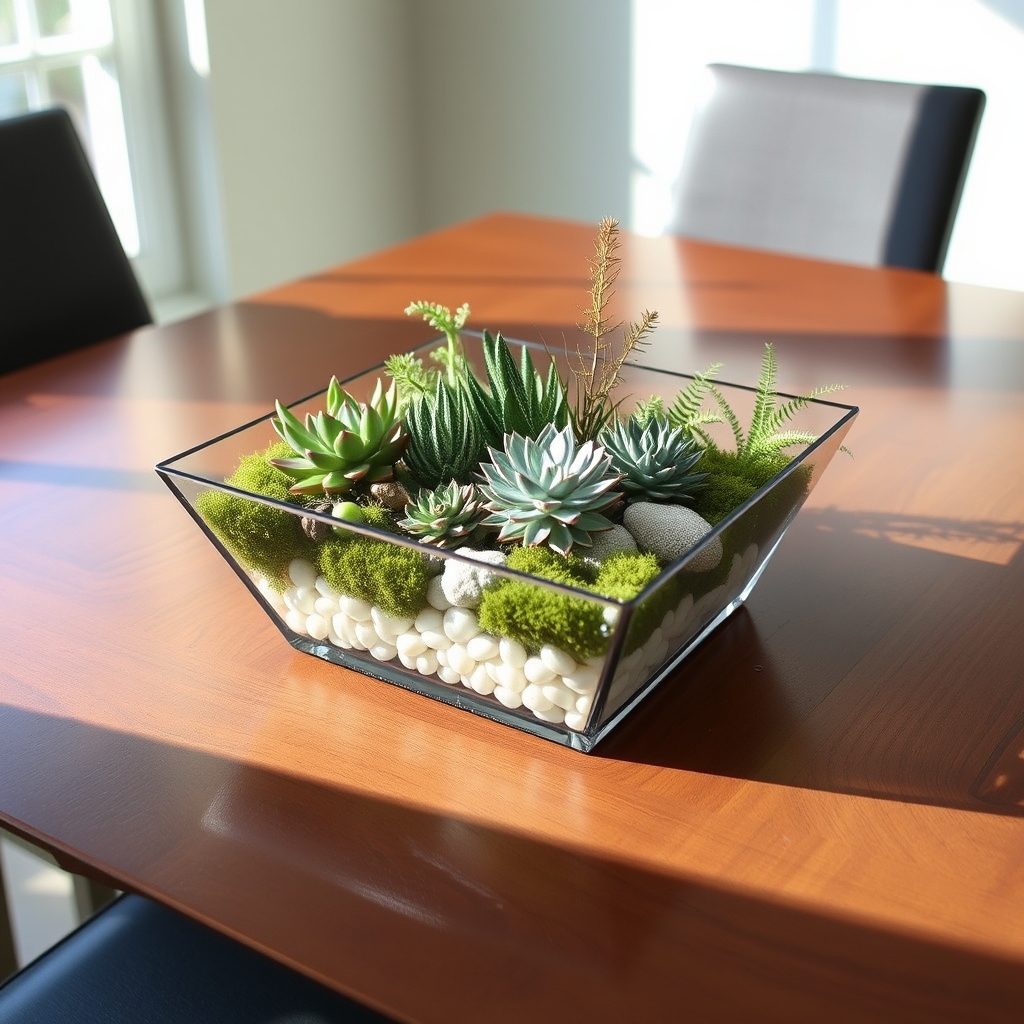
Living centerpieces offer a fresh, sustainable alternative to traditional floral arrangements for dining room tables. These displays typically feature potted plants arranged in decorative containers or trays, creating an eye-catching focal point that remains vibrant for months or even years.
Unlike cut flowers that need frequent replacement, living centerpieces incorporate small succulents, air plants, or compact tropical varieties that thrive indoors. The unique feature of these arrangements is their longevity – with proper care, they continue growing and evolving while serving as permanent table decor.
Plants can be grouped at varying heights, combined with natural elements like stones or moss, and easily rearranged to maintain visual interest throughout different seasons.
Layer Different Plant Heights for Visual Interest
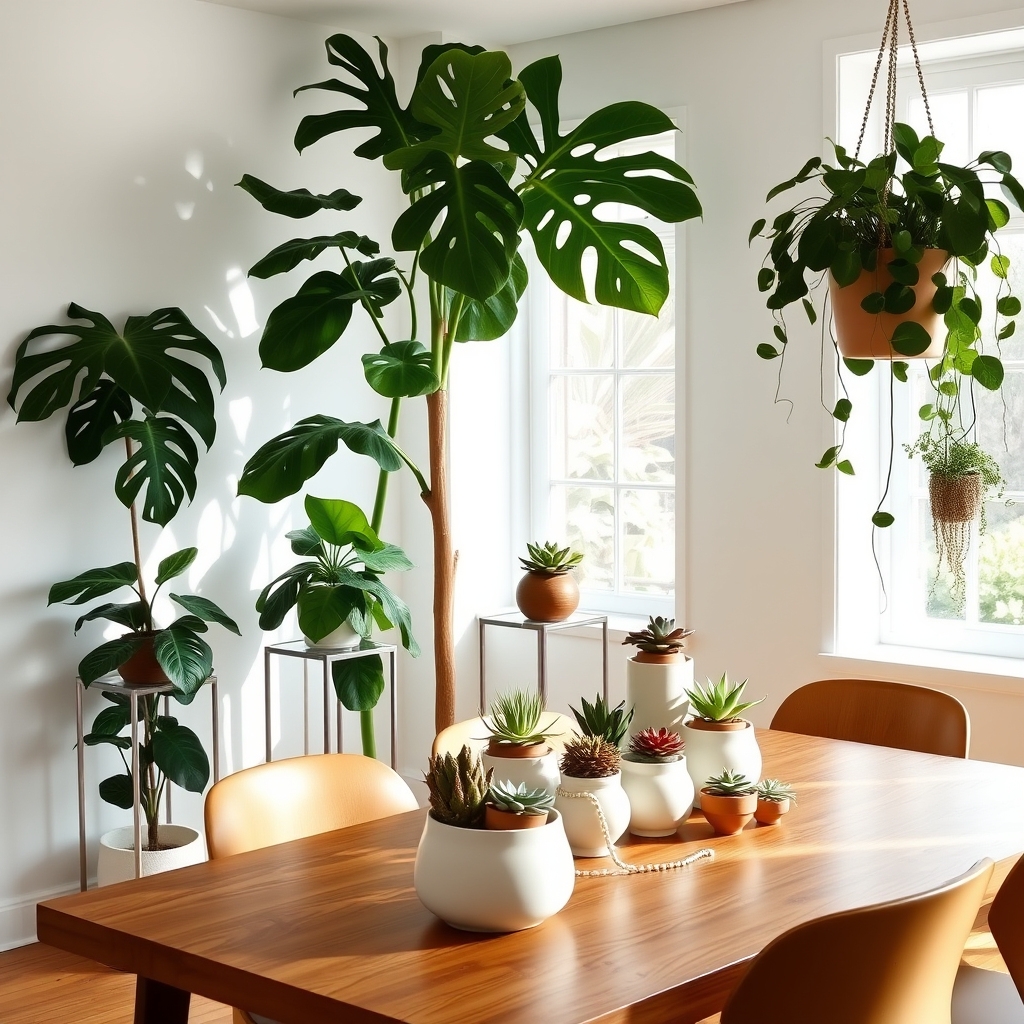
Layering plants at varying heights creates dynamic visual interest and depth in dining room spaces.
Tall floor plants like fiddle leaf figs or bird of paradise can serve as dramatic focal points, while medium-height plants on shelves or pedestals fill the middle ground.
Smaller tabletop plants and hanging varieties complete the arrangement by occupying lower and overhead spaces.
This multi-level approach prevents a flat, one-dimensional look and guides the eye naturally through the room.
The layered effect works particularly well when combining different leaf shapes, textures, and shades of green, creating a lush, garden-like atmosphere while maintaining an organized, intentional appearance.
Select Low-Maintenance Plants for Busy Areas
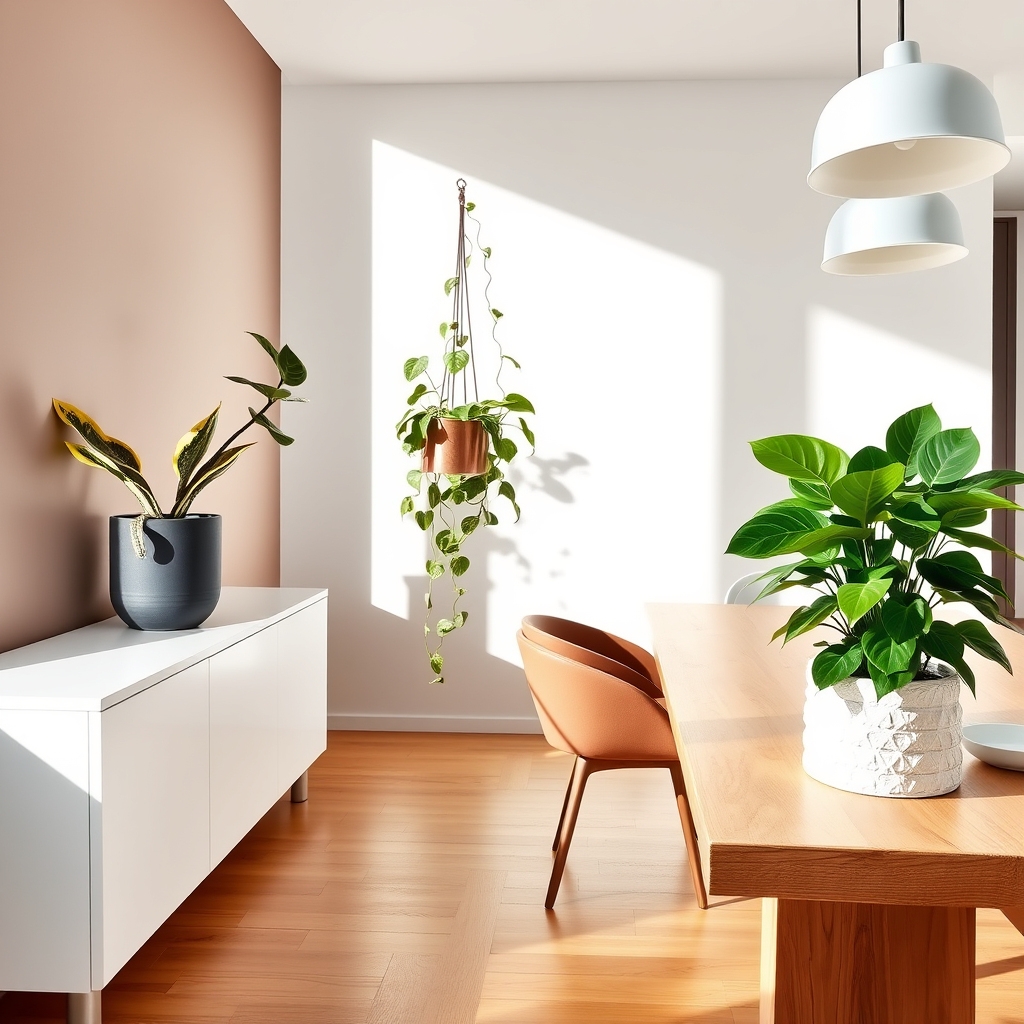
Low-maintenance plants are ideal choices for dining room spaces where people frequently move around and may not have time for extensive plant care.
These plants thrive with minimal attention, requiring basic watering schedules and moderate light conditions.
Popular low-maintenance options include:
- Snake plants (tall, upright leaves with distinctive patterns)
- ZZ plants (glossy, dark green leaves on arching stems)
- Pothos (trailing vines with heart-shaped leaves)
- Chinese evergreen (compact, variegated foliage)
These plants:
- Tolerate irregular watering
- Adapt to various light conditions
- Resist common pests
- Survive in average room temperatures
- Need minimal pruning or fertilizing
Strategic placement keeps them away from high-traffic areas while maintaining visual impact.
Most can thrive in decorative containers that complement dining room décor, adding greenery without demanding constant attention from busy homeowners.
Match Plants With Your Dining Room’s Style
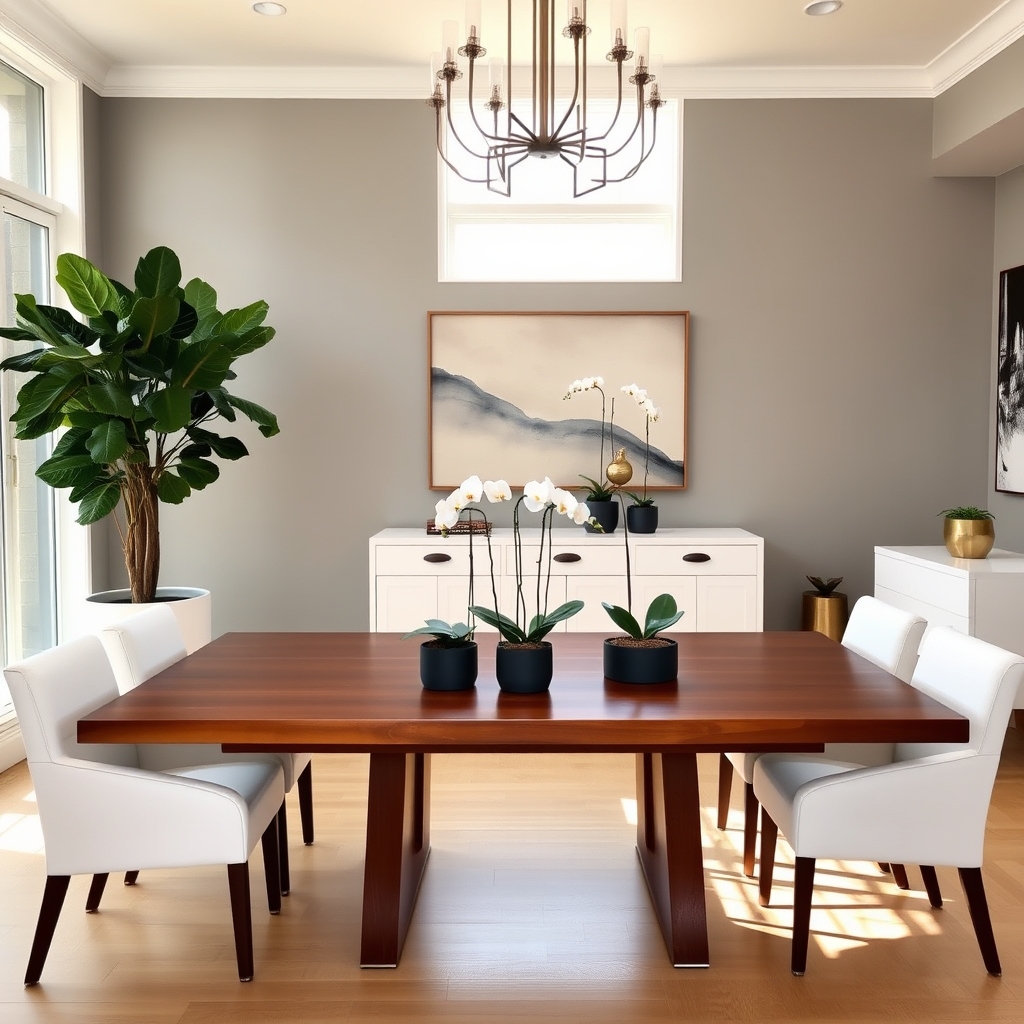
Matching plants with your dining room’s style involves selecting greenery that complements the existing interior design theme.
Modern dining rooms pair well with streamlined plants like snake plants or minimalist bamboo, while traditional spaces benefit from classic choices like peace lilies or ferns. Coastal-inspired rooms work beautifully with palm varieties, and rustic dining areas harmonize with earthy specimens like succulents or herbs.
The key elements to consider are:
- Plant shape and structure
- Leaf texture and color
- Container style and material
- Size proportion to room and furniture
- Growth habits that suit the room’s formality level
Strategic plant placement should enhance rather than compete with the dining room’s aesthetic, creating a cohesive look that flows with the overall design scheme.
Design a Hanging Garden Above the Table
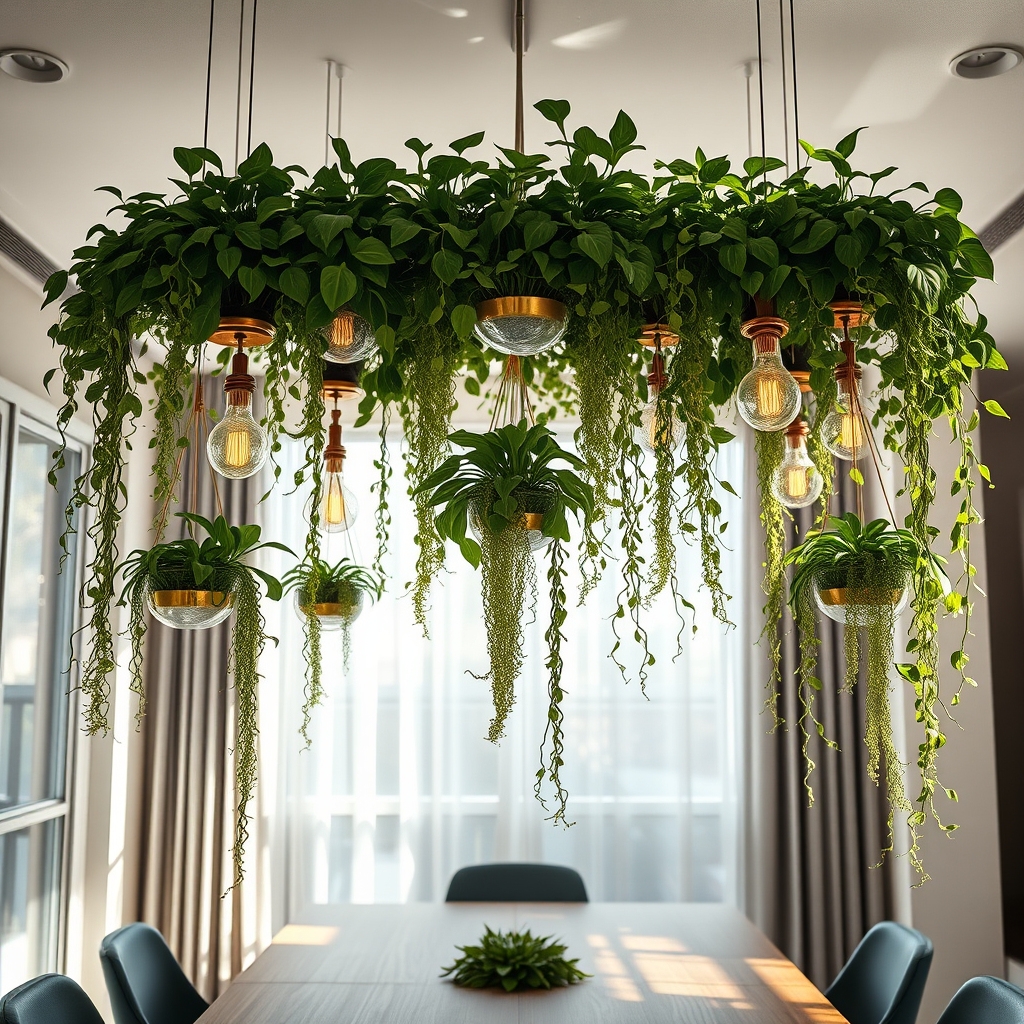
A hanging garden above the dining table creates a dramatic botanical canopy that transforms the dining space into an enchanting oasis.
The design typically features a collection of suspended plants at varying heights, incorporating hanging planters, macramé holders, or ceiling-mounted containers. Air plants, trailing pothos, spider plants, and string of pearls cascade downward, creating layers of living greenery overhead.
The arrangement requires secure mounting systems and proper spacing to ensure plants don’t interfere with diners below. Strategic placement of different plant varieties adds visual interest while maintaining a balanced, natural flow.
Proper lighting from above helps sustain plant health and creates appealing shadows on the dining surface. This elevated garden design maximizes vertical space and adds a distinctive natural element without taking up valuable table or floor area.
Balance Natural Light With Plant Placement
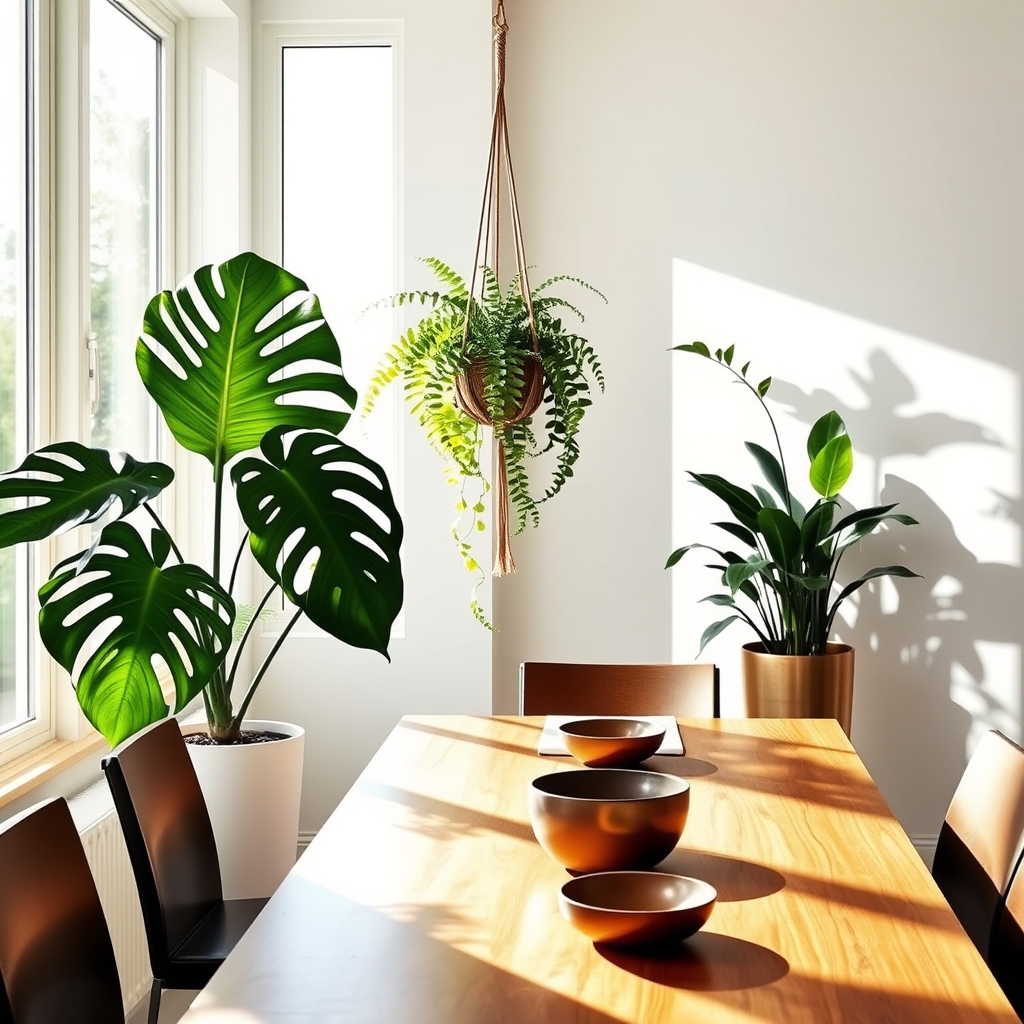
Balancing natural light with plant placement involves strategically positioning plants throughout the dining room based on available sunlight and each plant’s specific light requirements.
Plants near windows can thrive in bright, direct light, while shade-tolerant varieties work well in dimmer corners. A thoughtful arrangement might include hanging plants near east or west-facing windows, placing sun-loving specimens on windowsills, and setting low-light plants like snake plants or ZZ plants on sideboards away from direct sun.
This balanced approach creates visual depth while ensuring each plant receives appropriate light exposure for optimal growth and appearance.
Mix Textures and Leaf Patterns
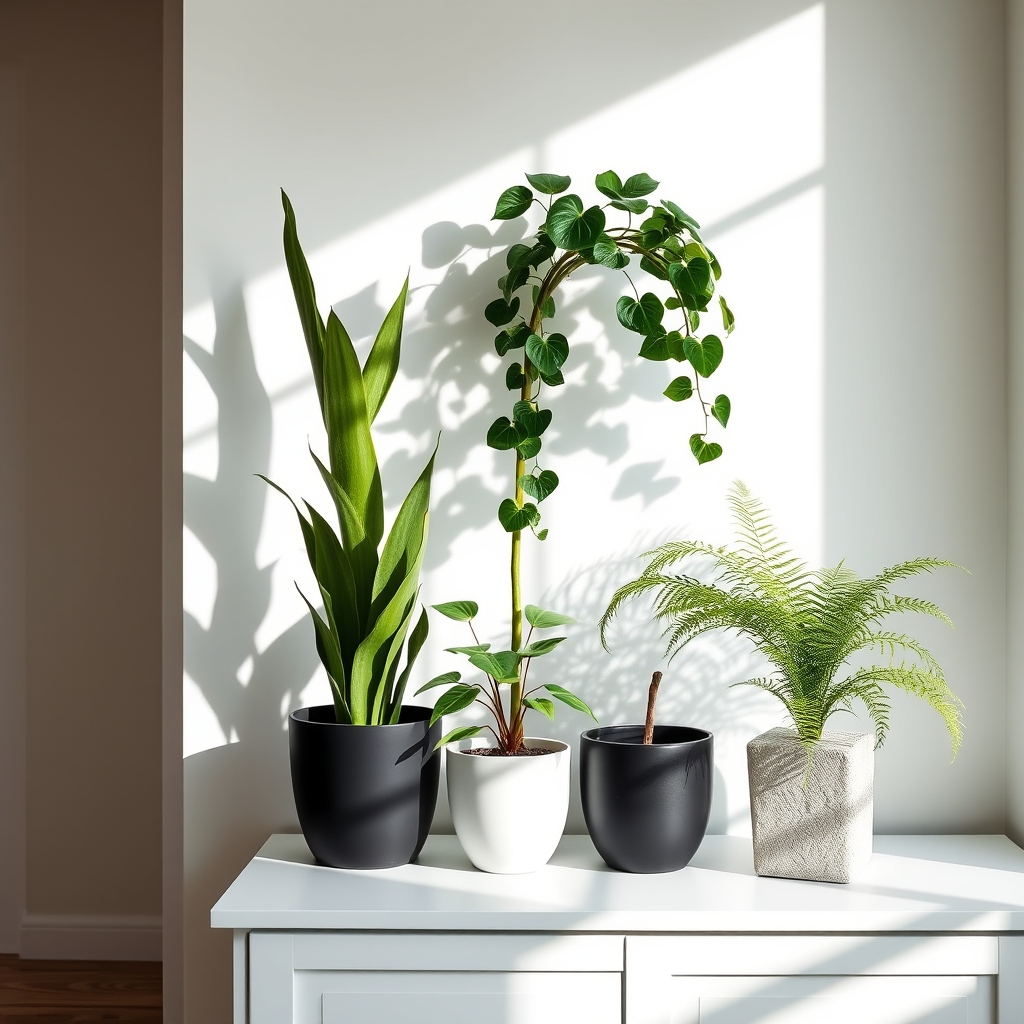
Mixing textures and leaf patterns creates visual interest and depth in dining room plant arrangements. Different leaf shapes, sizes, and surface qualities – from smooth to ruffled, glossy to matte – work together to form engaging displays.
Combining plants like sword-shaped snake plants with rounded pothos leaves, or pairing feathery ferns with broad-leafed philodendrons, produces dynamic contrasts. This layered approach prevents monotony and draws the eye through the space, making the dining area more visually appealing.
The varied textures also create subtle shadows and light play throughout the day, adding dimension to the room’s overall aesthetic.
Use Decorative Planters as Design Elements
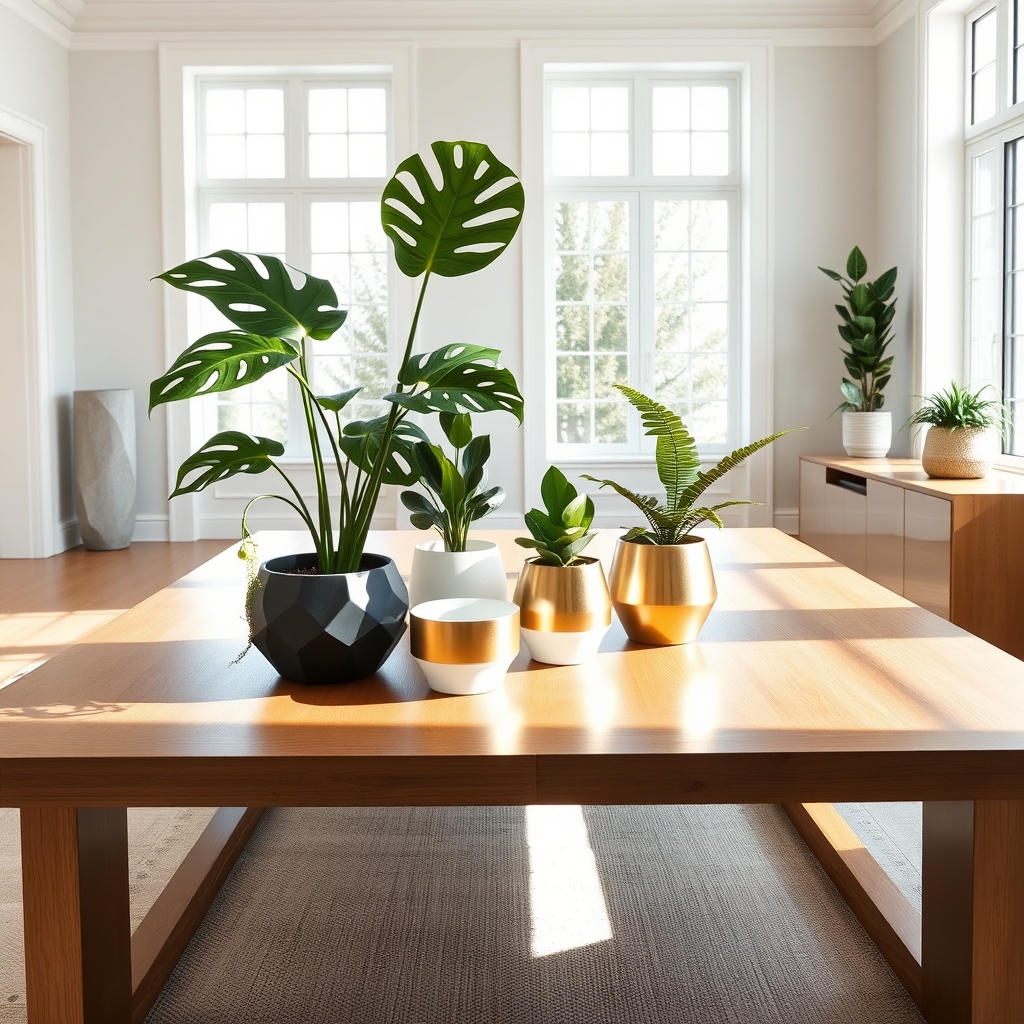
Decorative planters serve as both functional containers and artistic design elements in dining room spaces.
These vessels come in various materials like ceramic, metal, concrete, or woven baskets, featuring different shapes, textures, and finishes that complement the room’s style. The planters can be placed on the dining table, sideboards, or floor, creating visual interest at multiple heights.
Unique features include geometric patterns, metallic accents, hand-painted designs, or natural textures that add personality to the space while housing plants. Some planters incorporate built-in drainage systems or self-watering mechanisms, making them practical as well as beautiful.
Their sizes can range from small tabletop containers to large statement pieces, allowing for flexible arrangement options within the dining area.
Incorporate Seasonal Plants for Fresh Updates
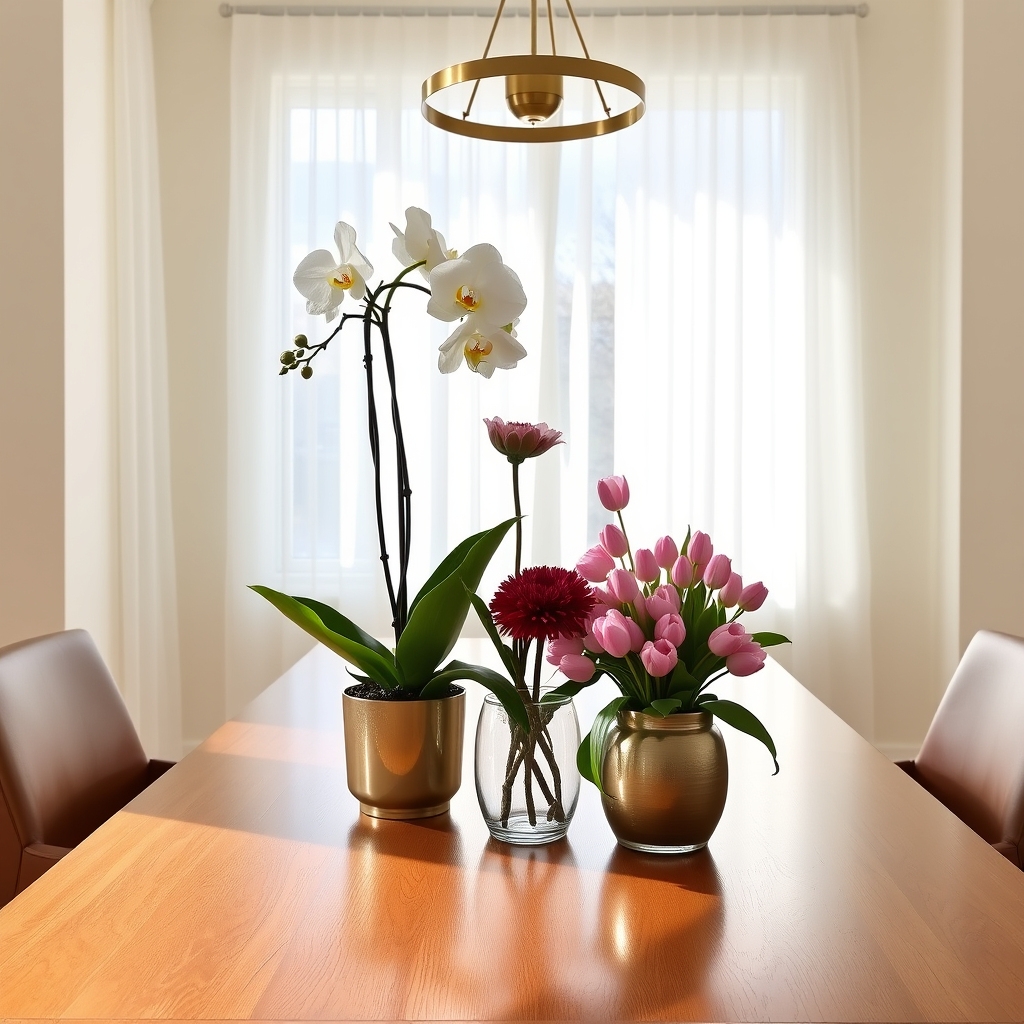
Seasonal plant rotation brings dynamic energy to dining room decor while celebrating nature’s changing cycles.
Plants like spring tulips, summer orchids, fall chrysanthemums, and winter poinsettias create visual interest that evolves throughout the year. This approach offers built-in opportunities to refresh the dining space’s look without major redesigns.
Key features include:
- Natural color transitions matching each season
- Varied heights and textures as different plants take center stage
- Lower maintenance as plants are switched out at peak condition
- Conversation starters during dinner gatherings
- Cost-effective way to maintain fresh decor year-round
The dining room remains engaging and current as seasonal specimens rotate in and out, with each plant variety contributing its unique characteristics to the overall ambiance.
